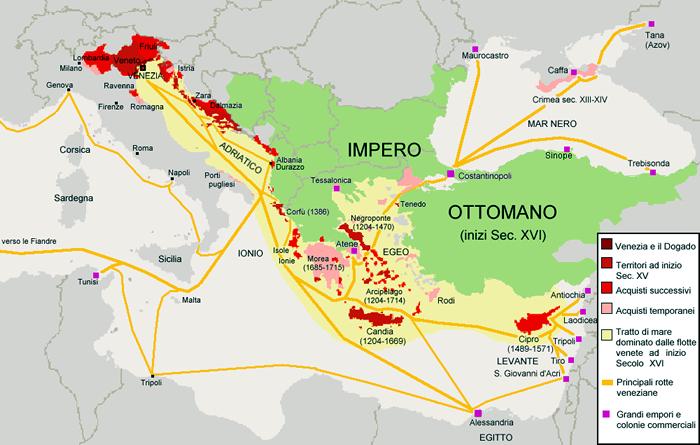 Republic of Venice
Republic of Venice

(Text by Duane R. Hurst © 2013)
Click on a link to view its information and pictures.
|
VENICE LINKS: Significant Event: Battle of Chioggia in 1380 AD Main Cities: Durazzo; Eraclea; Venice Time: 697-1797 AD Language: Italian; Latin; Venetian Personage: Lodovico Manin; Pietro II Candiano Religion: Christianity Related Country: Italy Brief History: I have included only a few items concerning the history of this republic. A good source for more details can be found on Wikipedia or in history books. |
|
|
EARLY YEARS:
Traditionally, authorities from Padua founded Venice on 25 March 421 AD. Historically, a cluster of lagoon communities banded together in an attempt to thwart marauding Lombards in the late 7th century AD, when Byzantine power waned. In 697 AD, Venetians instituted reportedly elected Paolo Lucio Anafesto as the first Doge (Duke). The first recorded Doge, however, was Orso (Ursus) Ipato in 726 AD. He came from Heraclea in southern Italy, but Eraclea was the power base for early Doges. THE REPUBLIC: Venetian nobles placed strict rules on a ruling Doge, who lived in an ornate palace. (See Another View.) Under the rule of Domenico Monegario (756-764 AD), Venice became a thriving seaport and maintained close ties to Desiderius, last king of Kingdom of the Lombards. Pro-Byzantine successor, Maurizio Galbaio, transformed Venice into a regional and international maritime power, which continued until its end in 1797 AD. Venice also became a military power during the rule of Pietro Tradonico (836-864 AD) and swept the sea of Slavic and Saracen pirates. Circa 6841 AD, Venice dispatched 60 galleys to help the Byzantines in a failed attempt to oust Arab Islams from Crotone in southern Italy. Subsequent rulers expanded Venetian control over Dalmatia and Istria. Venice also served as an important port during Christian crusades to wrest Israel from Islam. EXPANSION: During the 12th century AD, Venice secured the Adriatic Sea and built the Venetian Arsenal, a complex of state-owned armories and shipyards. The republic built forts to protect its commercial and maritime interests, such as at Nafplion in Greece. Doge Enrico Dandolo manipulated 4th Crusaders into capturing Zadar (1202 AD) and sacking Constantinople (1204 AD). Venice shamelessly demanded much of the loot plundered from the city, including the Four Horses of Saint Mark's basilica. Venice likewise gained nearly half of Byzantine territory, including Euboea and Crete. Such actions gave Venice greater control over trade in the region and against its rival, the Republic of Genoa. Doge Pietro Gradenigo ordered Venetian fleets against Genoese forces in 1295 and 1299 AD. The rivals fought a war between 1350 and 1381 AD. Venice initially suffered defeats, but triumphed in the Battle of Chioggia. Venice later lost Dalmatia and other territory during the 14th century AD to Louis I of Hungary. However, Venice reached its zenith during the rule of Doge Francesco Foscari (1423-1457 AD). Its power began to wane as Islam and the Ottoman Empire expanded. Venice lost fortresses at Argos and Negroponte. Despite loss of territory to the Ottomans by the late 14th century AD, Venice boasted the second largest city in Europe (Paris was number one) and possibly the most wealthy in the world. Venice boasted many notable sites, such as: Basin of San Marco; Dome of Santa Maria della Salute; and the Grand Canal. A Regatta on the Grand Canal was a famous event. END OF THE REPUBLIC: In 1499 AD, Venice allied with France and fought another war with the Ottomans. They lost a sea battle at Zonchio. A coalition of 208 Christian ships, including 110 galleys, soundly defeated a similarly large Ottoman fleet at Lepanto in 1571 AD. However, Ottomans seized the last Venetian stronghold on Cyprus at Famagusta during the same period. In 1714 AD, the Turkish Ottomans declared war with Venice and eventually seized the Venetian Kingdom of Morea. Genoa and other port cities in the region gained importance as Venice lost influence and trade. Lodovico Manin served as the final Doge from 1789 to 1797 AD, when Napoléon Bonaparte forced him to abdicate and terminated the Republic of Venice. |
|
|
© Page Publisher: Duane R. Hurst
|


